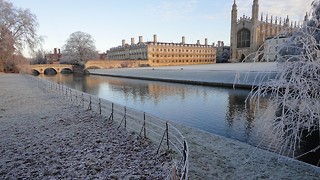Exhibition: Clive Head – Modern Perspectives
The National Gallery

I never thought I’d be disconcerted by a cup of cappuccino. But the offending mug in Clive Head’s painting Cottage Delight, which looms out of the picture, alarmingly tangible but dismayingly flat, certainly did. If Head managed to make the terribly middle-class drink almost disturbing, what he does to the café in which the coffee sits is even more startling.
Head uses unique perspectives which lack vanishing points rather than the conventional one or two, thereby creating a visual experience akin to real life: reality isn’t just mirrored but actively recreated. By eschewing a hierarchy of pictorial interest, which had been the basis of ‘realistic’ art since the Renaissance, Head’s works cause the eye to actively focus on certain objects without being passively led to particular elements within the picture by perspectives with vanishing points. The effect, then, is like looking at a slice of reality in which the eye and not the picture plane is the active ordering component. This gives our sight, and indeed ourselves, a peculiar agency which is perhaps largely unknown in the history of painting. Cubism got there before him in representing the world from all corners, but while Cubism is fragmentary, Head manages to bring together many disparate views into a seamless whole. It is as if he views the world with a monocular vision, making it our task to complete and complement the work by reliving the reality that he has literally re-presented.
It is a startling novelty and a testament to Clive Head’s innovation in the history of Western Art that his tiny exhibition has broken attendance records. People queued to see three paintings. They would never do so (I certainly wouldn’t) to go to look at the shabby corner at Haymarket, or a sad underground exit on a miserable London day, both of which he represents. But Clive Head, like all good poets and artists, has made an apparently mundane reality startlingly new and beautiful, so much so that a cappuccino will bowl you over.
 Comment / Anti-trans societies won’t make women safer14 November 2025
Comment / Anti-trans societies won’t make women safer14 November 2025 Comment / Be mindful of non-students in your societies12 November 2025
Comment / Be mindful of non-students in your societies12 November 2025 News / Controversial women’s society receives over £13,000 in donations14 November 2025
News / Controversial women’s society receives over £13,000 in donations14 November 2025 News / Stolen plate returned to Caius after 115 years12 November 2025
News / Stolen plate returned to Caius after 115 years12 November 2025 Theatre / The sultry illusions and shattered selves of A Streetcar Named Desire13 November 2025
Theatre / The sultry illusions and shattered selves of A Streetcar Named Desire13 November 2025









